Intel Core i7-11700K Review: Blasting Off with Rocket Lake
by Dr. Ian Cutress on March 5, 2021 4:30 PM EST- Posted in
- CPUs
- Intel
- 14nm
- Xe-LP
- Rocket Lake
- Cypress Cove
- i7-11700K
Gaming Tests: Far Cry 5
The fifth title in Ubisoft's Far Cry series lands us right into the unwelcoming arms of an armed militant cult in Montana, one of the many middles-of-nowhere in the United States. With a charismatic and enigmatic adversary, gorgeous landscapes of the northwestern American flavor, and lots of violence, it is classic Far Cry fare. Graphically intensive in an open-world environment, the game mixes in action and exploration with a lot of configurability.
Unfortunately, the game doesn’t like us changing the resolution in the results file when using certain monitors, resorting to 1080p but keeping the quality settings. But resolution scaling does work, so we decided to fix the resolution at 1080p and use a variety of different scaling factors to give the following:
- 720p Low, 1440p Low, 4K Low, 1440p Max.
Far Cry 5 outputs a results file here, but that the file is a HTML file, which showcases a graph of the FPS detected. At no point in the HTML file does it contain the frame times for each frame, but it does show the frames per second, as a value once per second in the graph. The graph in HTML form is a series of (x,y) co-ordinates scaled to the min/max of the graph, rather than the raw (second, FPS) data, and so using regex I carefully tease out the values of the graph, convert them into a (second, FPS) format, and take our values of averages and percentiles that way.
If anyone from Ubisoft wants to chat about building a benchmark platform that would not only help me but also every other member of the tech press build our benchmark testing platform to help our readers decide what is the best hardware to use on your games, please reach out to ian@anandtech.com. Some of the suggestions I want to give you will take less than half a day and it’s easily free advertising to use the benchmark over the next couple of years (or more).
As with the other gaming tests, we run each resolution/setting combination for a minimum of 10 minutes and take the relevant frame data for averages and percentiles.
| AnandTech | Low Resolution Low Quality |
Medium Resolution Low Quality |
High Resolution Low Quality |
Medium Resolution Max Quality |
| Average FPS | 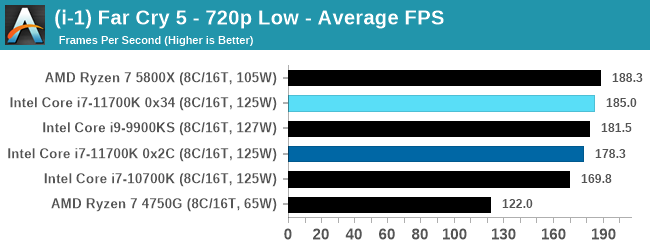 |
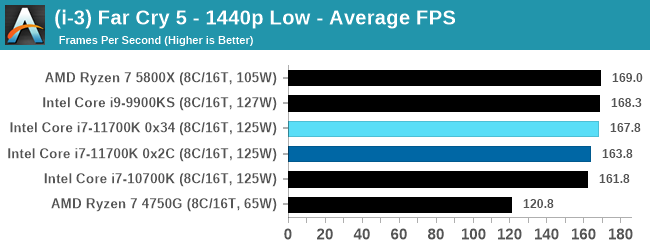 |
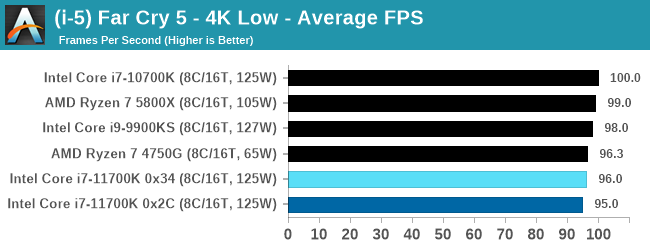 |
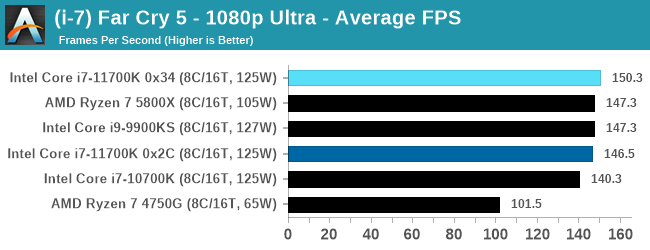 |
| 95th Percentile | 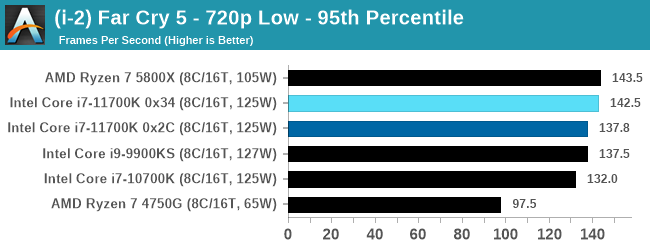 |
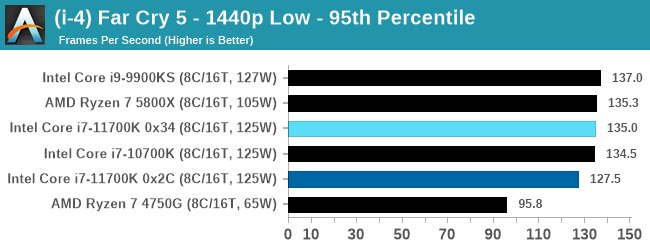 |
 |
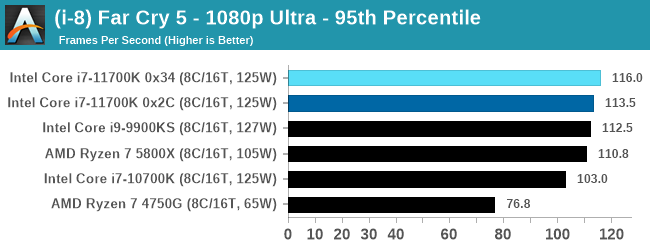 |
All of our benchmark results can also be found in our benchmark engine, Bench.












541 Comments
View All Comments
DV8_MKD - Friday, March 5, 2021 - link
Yeah, agree. That would be interesting to see.IanCutress - Friday, March 5, 2021 - link
Adding in power detection during a test will often slow it down a bit, or require running the tests twice (they already take 24hr) and then parsing the data (probably more time than it's worth). Which would all lend to a slower review cycle. No easy way to automate it, unfortunately.lmcd - Friday, March 5, 2021 - link
Maybe true but hand-picking a few benchmarks would be nice. The power draw section is opaque from our vantage because we don't know what performance looks like at max power draw.idimitro - Friday, March 5, 2021 - link
A wall meter can be automated, easily. Even system level power consumption will be more useful that the TDP figures published by the manufacturers these days.shabby - Friday, March 5, 2021 - link
Ah ok, can you maybe hand pick a few tests? It's an interesting metric.Spunjji - Saturday, March 6, 2021 - link
Agreed here. I get that it's a big ask, but it would be very useful to see in terms of sizing cooling up for system builds.SL2 - Friday, March 5, 2021 - link
"...the only parts readily available on retail shelves right now are from Intel."Maybe in North America, but not in Europe. The only CPU missing here is the 5950X, the other models are in stock.
Milk Fondu - Friday, March 5, 2021 - link
This.. is rough. As someone who has been team blue for a long time, and who knew this launch was going to be bad: this is bad. I'm sure things will get better with a bios update or two, but 14nm has just been stretched too thin. It's begging to be put down.lmcd - Friday, March 5, 2021 - link
I mean, part of the problem is simple though: AVX is a waste of die space. An onboard GPU appears to be a waste of die space -- AMD sure doesn't need to sell one on its desktops. And a modular approach on desktop does wonders for yields.This launch should've been 14nm, 10 cores, more spaced out in the die (if possible) and no iGPU on the die at all. Saves the Xe backport money and produces the same effect, since these real-world power numbers are unsustainable in anything other than a powerful workstation.
nandnandnand - Friday, March 5, 2021 - link
AMD is expected to add an iGPU chiplet starting with Zen 4. It might be added for machine learning acceleration in addition to entry-level graphics.Intel will actually have RKL chips without iGPU, for what that's worth. i7-11700KF and i9-11900KF. I don't think it will improve the thermal performance though, just lower the price a few dollars.